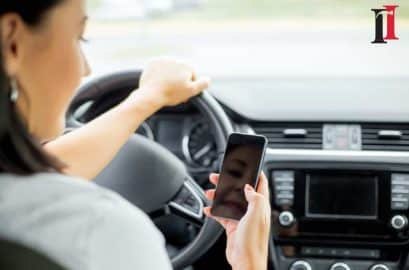What To Do About Texting and Driving
Last updated Tuesday, November 5th, 2024

The best steps to combat the dangers of texting and driving include:
- Be familiar with the texting and driving laws in your state
- Use a cell phone car mount in your vehicle to go hands-free
- Use a smartphone app that disables texting and messaging while driving
- Turn on the “Do Not Disturb While Driving” feature on your smartphone
- Take the national pledge to avoid texting and driving
Changing texting and driving behaviors can save lives. April is National Distracted Driver Awareness Month and we’ve highlighted some of the most dangerous behaviors, along with solutions to make significant shifts toward safety.
How Easily We Become Distracted While Driving
Some of the more common ways that drivers of cars, semi-trucks and other large vehicles become distracted behind the wheel include:
- Texting while driving
- Talking on cell phones while driving
- Checking messages & emails while driving
- Looking at a map
- Eating while driving
- Changing the radio station
- Reaching for something
- Talking to a passenger
By far the most significant distraction on the roads comes from cell phone use while driving.
Texting and Driving Statistics
In the year 2019, 48 states joined a ban on text messaging for all drivers. 20 states currently prohibit all drivers from using hand-held cell phones while driving.1 Texting and cell phone use continue to contribute as major causes of crashes for trucks, cars, bicyclists and pedestrians.
Some of the most glaring numbers for car accidents due to texting include the following:
- Of the 3,166 distracted driver fatalities recorded in 2017, 434 involved a driver using a cell phone.
- Of the 3,255 distracted driver fatalities for 15 to 19 years old recorded in 2017, eight percent (271) were distracted at the time of the collisions.2
Texting and Driving: Laws and Solutions
The responsibility lies upon each of us to take action and change dangerous behaviors regarding cell phone use. Knowing the law is a common-sense place to start, but should be followed by active solutions that implement safe practices while driving.
A Reminder of Texting and Driving Laws
In the states where our offices exist, specific laws regarding mobile phone use are in place:
- Kentucky: Drivers 18 and under must not use a mobile device while driving. Drivers of all ages must not text while a vehicle is in motion. Violators of these laws face fines and the possibility of a three-point deduction on their driver’s license.3
- Indiana: All drivers are forbidden from sending all forms of mobile messages including texting and emailing. Violators face fines up to $500.4
- Ohio: All drivers are prohibited from “the use of handheld electronic devices for text communication.” Penalties include two points off of their license and fines up to $250.5
Actions to Change Cell Phone Distracted Driving
Handheld devices are extremely dangerous for drivers. Getting cell phones out of the hands of drivers can be considered one of the most important first steps toward change. Solutions to make this happen are quite easy to adopt.
Start By Using a Cell Phone Car Mount
Use of a car mount that docks and holds the cell phone on the front panel is an essential part of driving these days. This won’t prevent all driving distractions from the phone, but it will get it out of your hands.
Smartphone Apps & Do Not Disturb While Driving
There are a number of smartphone apps now available that have integrated motion sensor technology to disable texting and other messaging features while driving. This is a common sense method to overcome the temptation of grabbing your phone and messaging while driving.
A number of devices, including iPhone and Android now feature a Do Not Disturb While Driving setting on the mobile device. These can be set manually each time you get in the vehicle. But for more consistent use, they also allow the features to be auto-engaged when detecting vehicle motion.
Keep in mind that each individual state governs which practices and supporting devices can be used, along with any additional guidelines that must be followed.
Make a Pledge and Stick With It
Once again this year, the National Security Council (NSC) has partnered with organizations to encourage a personal pledge to change our texting and driving habits. Review the pledge below and make your own personal commitment to safe driving.
I pledge to Just Drive for my own safety and for others with whom I share the roads. I choose to not drive distracted in any way – I will not:
- Have a phone conversation – handheld, hands-free, or via Bluetooth
- Text or send Snapchats
- Use voice-to-text features in my vehicle’s dashboard system
- Update Facebook, Twitter, Instagram, Vimeo or other social media
- Check or send emails
- Take selfies or film videos
- Input destinations into GPS (while the vehicle is in motion)
- Call or message someone else when I know they are driving
Take the pledge by clicking here.
Call Isaacs & Isaacs Distracted Driving Accident Lawyers Today
If you’ve been involved in an accident where distracted driving played a factor, the car accident attorneys at Isaacs & Isaacs will provide a free review of your injury claim. Our goal is to provide you and your loved ones with the justice and compensation you deserve. Call us 24/7 at 800-333-9999.
Isaacs & Isaacs, Primary Office
1601 Business Center Ct
Louisville, KY 40299
1. Distracted Driving | Cellphone Use ↩
2. [Traffic Safety Facts – Distracted Driving in Fatal Crashes, 2017 ]↩
3. [ Distracted Driving Laws in Kentucky]↩










